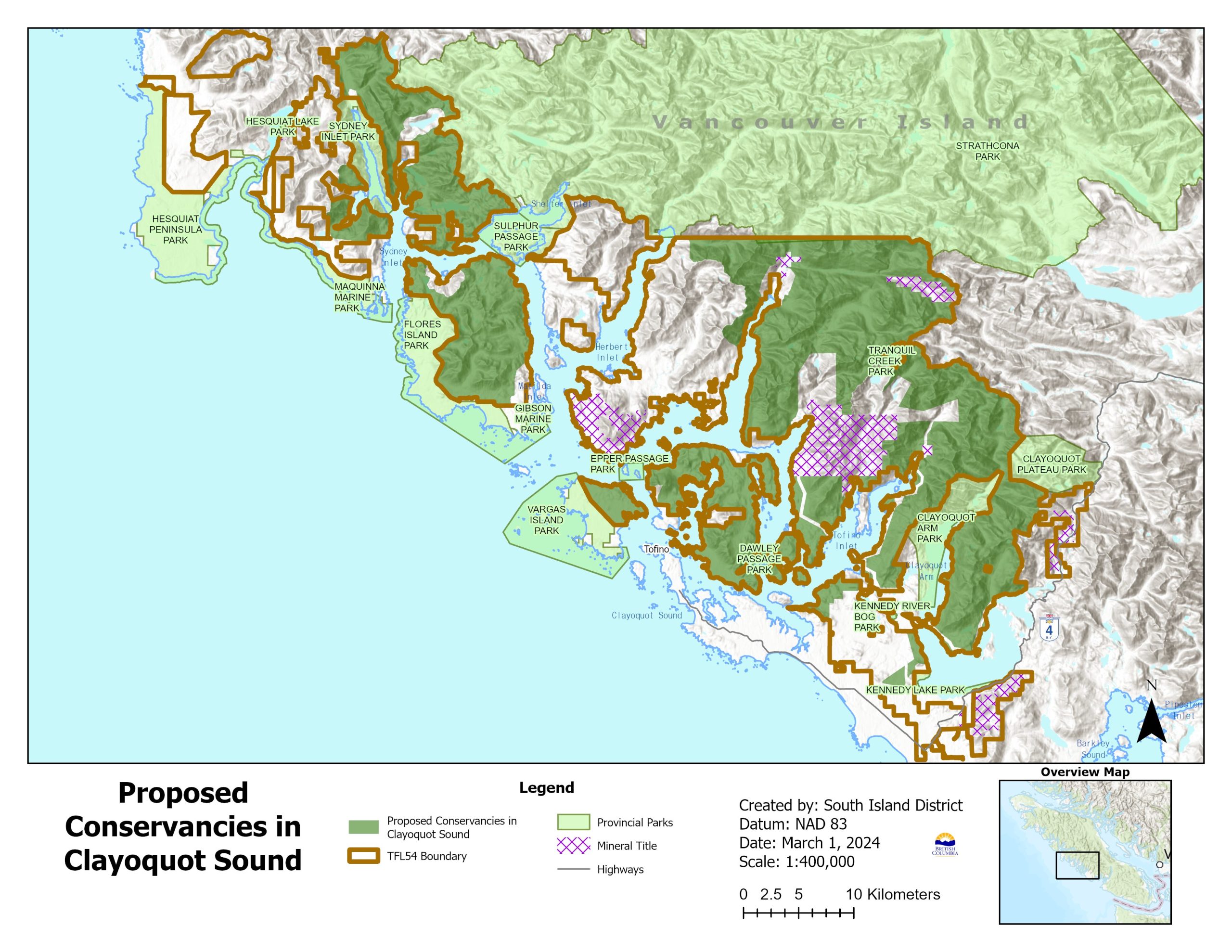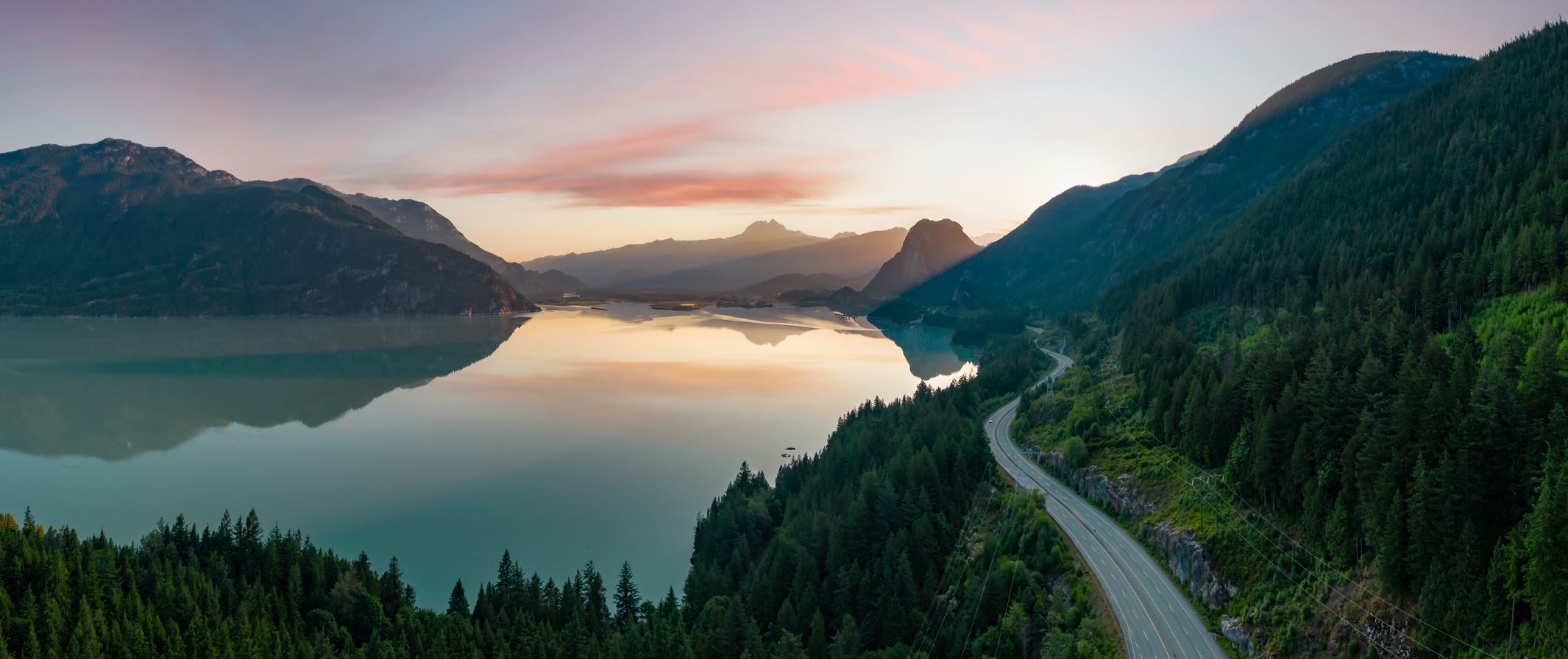
Clayoquot Sound Conservancies
On this page:
Overview
Who:
- The Ministry of Forests
- The Ministry of Environment and Climate Change Strategy
- The Ministry of Water, Land and Resource Stewardship
- Ahousaht First Nation
- Tla-o-qui-aht First Nation
What: The conversion of approximately 77,000 hectares of Tree Farm License 54 (TFL 54) into conservancies in the Clayoquot Sound
Where: Clayoquot Sound, Vancouver Island
Why: To increase ecological protections and opportunities for economic development in Clayoquot Sound through supporting the land use visions of Ahousaht and Tla-o-qui-aht First Nations
How: Online
Engagement summary
The Province is collaborating with the Ahousaht and Tla-o-qui-aht Nations First Nations on options for increased protections of important values, including old growth forests.
As part of ongoing Land Use discussions with First Nations in Clayoquot Sound, 77,000 hectares of new proposed conservancies under the Park Act are being proposed with 55,000 hectares remaining within forest tenures. This is part of long-term planning for the area currently within Tree Forest License (TFL) 54 – the only TFL in Clayoquot Sound.
These proposed conservancies align with:
- The ʕaḥuusʔatḥ Wiklakʷiiḥ (wick-lakwee-ah) Cultural and Natural Areas identified in the ʕaḥuusʔatḥ “Iisaakstał Land Use Vision.” Iisaakstał is pronounced “ee-sock-stalth” and mea ns to respect one another; inclusive of lands, waters, animals, and people
- The Tla-o-qui-aht Tiičmis (pronounced ‘teach-miss” and meaning life source, biodiversity and the environment) areas identified in the Tla-o-qui-aht / ƛaʔuukʷiʔatḥ Land Use Vision as Tribal Parks
The Province is working with these First Nations on this effort to balance ecological and cultural protections with opportunities for reconciliation and economic development in the Clayoquot Sound. We would like to understand existing uses of the lands identified in the proposed conservancies and how these uses may be impacted.
No changes to forest business activities outside of TFL 54 are being considered as part of the proposed conservancies. The Province and Nations will discuss roads, mineral titles, and other exclusions in future discussions around the ongoing implementation of their respective Land Use Visions.
FAQs
Conservancies are lands set aside under the Park Act for:
- The protection and maintenance of their biological diversity and natural environments
- The preservation and maintenance of social, ceremonial and cultural uses of First Nations
- The protection and maintenance of their recreational values
- Development or use of natural resources in a manner consistent with the purposes of the above
In September 2020, the Province released the Old Growth Strategic Review Report (PDF, 8MB) and committed to a new integrated management approach for old growth forests that provides for environmental, economic, and reconciliation benefits. At that time, the Province also announced immediate deferral for old growth harvesting in 9 areas, including in Clayoquot Sound.
The proposed conservancies include old growth forests and support several endangered and threatened species. New conservancies supported by the reconfiguration of TFL 54 removes the need for the deferral area in Clayoquot Sound and is an incremental step in realizing First Nations’ land use visions.
Commercial logging, mining and hydroelectric power generation (other than local run-of-the-river projects) are prohibited. A local run-of-the-river project is defined as one that provides power to a development within a conservancy or to a community that does not otherwise have access to hydro-electric power.
In addition, no on-site oil and gas exploration, development or production may occur in a conservancy. Directional or horizontal drilling for petroleum and natural gas from outside a conservancy may occur.
The designation type (conservancy) defines what is allowable, and regulations, management direction and policies provide further detail on what types of activities may be appropriate in a specific area.
Commercial recreation may be able to continue as currently permitted upon the approval of a Park Use Permit. Park Use Permits may include terms and conditions necessary to ensure protection of the conservancy’s values.
The proposed conservancies exclude the areas associated with currently permitted commercial (non-recreation) activities such as aquaculture, communications (e.g., cellular towers, etc.), hydroelectric activities and mining/mineral exploration.
Mining is not an allowable activity in conservancies. However, there are no existing mineral titles included within the boundaries of the proposed conservancies. Please review the map to see how conservancy boundaries have been delineated to maintain access to areas with mineral titles.
There are existing forestry permit roads in several locations within the areas. These roads are being excluded from the proposed conservancies. Work will be undertaken to deactivate many of these roads. Deactivation prevents access by motor vehicles, removes bridges and culverts and prevents erosion to protect adjacent aquatic habitats and water quality. Once deactivated these areas could be added into the conservancies in a future process.
No. There are no private lands included in the proposed conservancies.
Ecological and cultural protection along with reconciliation are priorities for the proposed conservancies. The development of infrastructure and amenities to enhance priorities and opportunities for public access will be considered by the Province and First Nations in the future.
The Province is working collaboratively with Ma-Mook Natural Resources Ltd. (the holder of the only TFL in Clayoquot Sound) on their applications to expire existing Timber Licenses within the TFL and delete the areas that fall within the proposed conservancies. Removing the conservancies from the TFL will result in a review of the allowable annual cut. This review will assess a proportional reduction in harvesting opportunity in the remaining forest management areas within TFL 54.
No changes to forest business activities outside of TFL 54 are being considered as part of this process. The Province is working with Ma-Mook Natural Resources Ltd. and the First Nations partners on applications to subdivide and transfer the forest harvesting rights for those areas of TFL 54 that are not identified as potential conservancies. The Province will work with the Nation tenure holders on their interest to harvest timber in other areas of Clayoquot Sound as an economic opportunity for their communities.
Map
Results
Effective June 26, 2024, 10 conservancies were established to support reconciliation, conservation of old-growth forests and healthy ecosystems, as well as provide clarity on areas that will continue to be managed for forestry to support timber supply. Following overwhelming support during public consultation, this process now stands as an example of moving forward with the full involvement of First Nations in implementing old-growth strategies and conserving ecosystem health and biodiversity.







